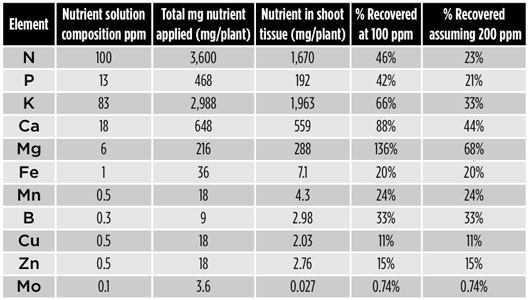3/26/2013
The Woes of Over-Fertilizing
Dr. Royal Heins
I’m tired of reading crop fertilizer recommendations of 200 ppm N from a balanced fertilizer on every crop culture guide. Everyone growing and fertilizing plants (and people writing fertilizer recommendations) should at a minimum rethink their nutritional programs if they’re still using this recommendation.
So how much fertilizer does a plant really need? How much nitrogen is in a plant at time of shipment? Have you ever wondered what percent of the fertilizer that’s applied to a crop actually accumulates in the plant by the time of shipment? And how much gets leached into the environment?
Garden mums are reputed to have “high” nutritional requirements—just read most historic sets of recommendations for producing garden mums. The recommendations will say to feed 300 to 400 ppm nitrogen to establish the plants.
But how much nitrogen and other nutrients are actually in a garden mum at flower and time of shipment? And how does this compare with delivered nutrients during a crop cycle? Dr. Mark Yelanich at Metrolina Greenhouses cooperated with me to make such a calculation.
To do our calculations, garden mums were grown with 100 ppm nitrogen from a 17-5-17 nutrient solution supplemented with minors to the ppm as shown in the table. At flower, high-quality saleable plants were harvested, dried, weighed and tissue analysis conducted. We then calculated the total amount of each nutrient that was in the plant, as well as how much of each nutrient was applied in total to the crop based on the fertilizer concentration, water applied per pot and number of irrigations.
For a plant considered to require “high” levels of nutrients, the actual recovery percentage of nutrients from the “low” 100 ppm nitrogen fertilizer applied was mostly under 50% and in most cases under 33%. If the crop had been irrigated with 200 ppm, the recovery of macro-nutrients would have been pitiful (see table).

The only exceptions were calcium and magnesium where the apparent recovery was very high, but this was due to recovery of these elements from the limestone and gypsum used in the starter charge.
The results of this small experiment and the experience of many growers has shown that floricultural bedding and pot plant crops have been over-fertilized for decades, resulting in truckloads of fertilizer being wasted by greenhouses.
So, how did these high fertilizer rates come to be recommended? My best hypothesis is that minor nutrient deficiencies, especially iron and perhaps manganese, led to high rates of fertilization. Requirements for minor nutrients in floricultural plants seem somewhat independent of macro-nutrient delivery. Historically, minor nutrients have been added to pre-mixed fertilizers sold to growers such that “adequate” rates are applied when 200 ppm nitrogen is applied.
If a grower decreases nitrogen to say, 100 ppm, then the minor nutrients are also reduced to 50% of the amount delivered at 200 ppm and, in some cases, results in minor nutrient deficiencies. Application of higher rates of nitrogen, and therefore higher rates of minors, corrects the chlorosis leading one to conclude that the plants require the higher nitrogen fertilization rates, when in fact they only required a higher minor nutrient delivery.
The solution to healthy crop growth at lower nitrogen (and phosphorous and potassium) concentrations is to be certain the minor nutrients are supplemented to that applied at 200 ppm nitrogen.
So, do you want to reduce your environmental impact while using less growth regulators this spring? Then reduce the fertilizer application to the plants to 100 to 125 ppm nitrogen from a fertilizer like 17-5-17, but top off the minors in the final solution to about a total of 1 ppm iron, 0.5 ppm manganese, 0.5 ppm zinc, 0.25 ppm copper, 0.25 ppm boron and 0.01 ppm molybdenum.
Done properly, your plants will be healthy and green and there will be less fertilizer used, less runoff and less growth regulator required. One last word of advice based on years of consulting with growers: It is critical that your injector works properly. Wasteful rates of high fertilizer concentration often cover up sins of poor injector maintenance. You must check the EC of your fertilizer solution daily to make sure you’re putting on what you plan to put on or nutrient deficiencies will likely occur.
GT
Dr. Royal Heins is Senior Technical Specialist with Fides-Oro and can be reached at r.heins@fides-oro.com or on the company website. Go to www.fides-oro.com and click on “Ask the Doctor.”